What is Blockchain and Why Does it Matter?
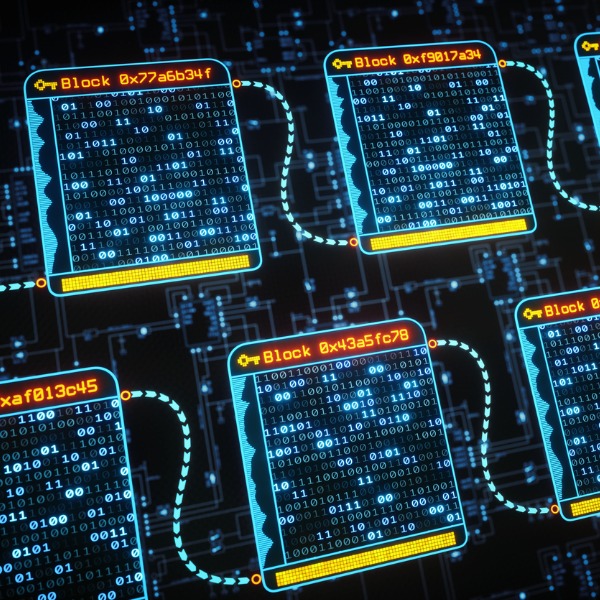
Binary numbers and blocks (matejmo, iStockphoto)

Binary numbers and blocks (matejmo, iStockphoto)
How does this align with my curriculum?
Learn about blockchain and how it is used to keep data safe.
In the ever growing world of technology, you may have heard about something called blockchain. Did you ask yourself if it involved blocks and chains? Maybe not. But if you did, you would be right! It DOES involve blocks and chains. More about that in a bit…
Blockchain is the technology behind the cryptocurrency Bitcoin. Bitcoin still uses its original blockchain, but there are now even more versions of blockchain out there that are used by other cryptocurrencies. Not only is blockchain used for cryptocurrency, it is also used to protect other types of digital data.
Blockchain for Kids | Blockchain Explained for Beginners (2018) by Lisk (2:42 min.)
Blocks and Chains
So what exactly is blockchain? A blockchain is a list of digital records. We call the groups of records blocks. Each block of records is connected , or “chained” to other blocks of records. The blocks are kept secure online using cryptography. Let’s take a detailed look at each of the parts of the system.
Blocks can be groups of any kind of data. For Bitcoin, the records in blocks are lists of transactions between people. For example, here is a transaction:
Person X gives Person Y $50
In other blockchain systems, the records can include information such as how much wifi someone uses or the stops a product makes from the factory to a store. For this Backgrounder, we will stick to the system used for Bitcoin.
Once the transactions in a block have been approved, the block can be “closed” and added to the “chain”. In the image below, the purple blocks have been approved and added to the blockchain. The blue block still needs to be checked.

Approved blocks are connected via chains (©2023 Let’s Talk Science).
Image - Text Version
Shown is a colour diagram illustrating the links between approved blocks in blockchain.
Four squares are arranged in a row across a white background. The first three are purple with green check marks at the top. These are connected by teal chain links. The fourth square is blue, with no checkmark. It is not linked to the others.
How are transactions approved?
Approving what gets into a chain is an important part of what makes blockchain a secure way of sharing information. Let’s see how this works.
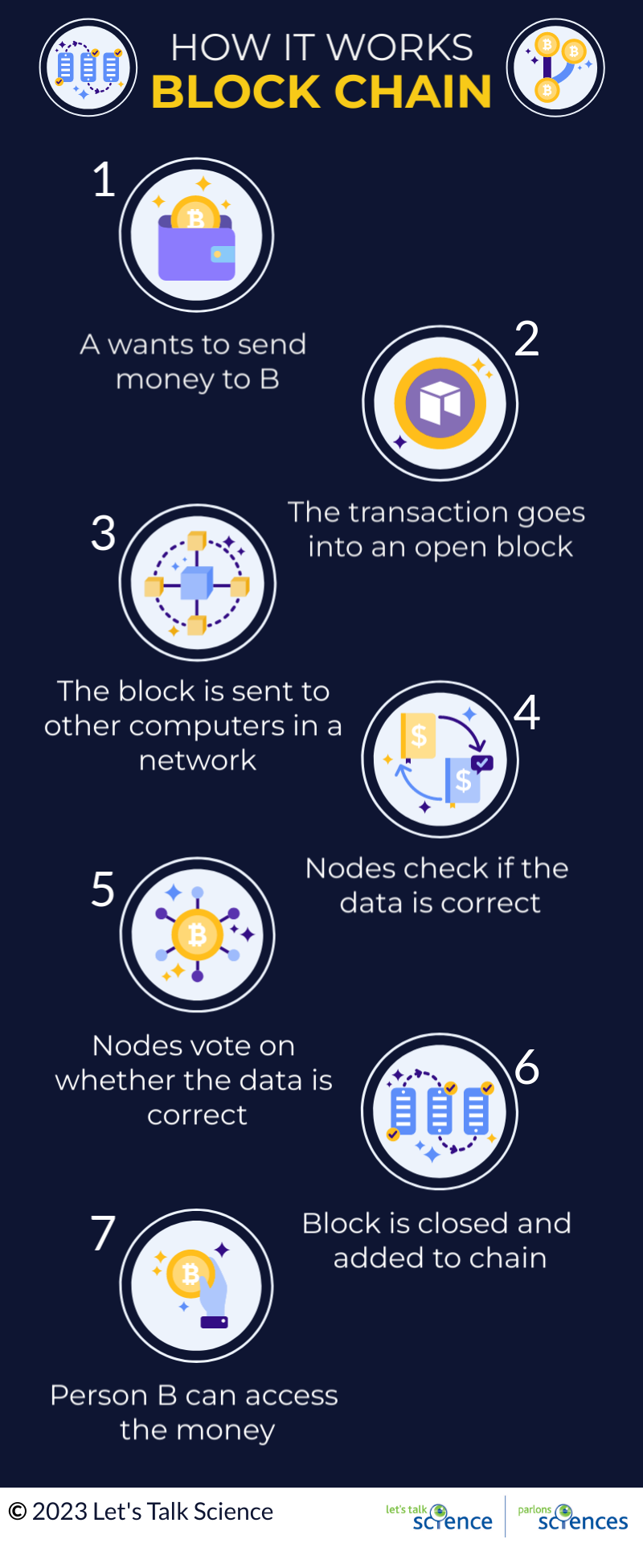
Blockchain infographic (©2023 Let’s Talk Science).
Image - Text Version
Shown is a colour infographic that explains how blockchain works.
The title "How it Works: Blockchain," is in capital letters in the top centre of the image, between two small, round illustrations. The left illustration is three rectangular blocks connected by curved purple chains. The right illustration shows three gold coins connected by a dark blue stripe and a purple stripe. Below, seven steps are listed, on a dark blue background, each with a larger, round illustration.
Step 1 reads, "A wants to send money to B". The illustration is a sparkling gold coin embossed with the letter B, in a purple wallet.
Step 2 reads, "The transaction goes into an open block." The illustration is a purple cube, open on the bottom and the front.
Step 3 reads, "The block is sent to other computers in a network." The illustration is a purple cube connected by blue lines to four gold cubes around it. The gold cube are connected by a dotted, circular line.
Step 4 reads, "Nodes check if the data is correct." The illustration has a gold rectangle with a white dollar sign, and a blue rectangle with a dollar sign and a checkmark on it. These are connected by a blue curved arrow and a purple curved arrow that form a continuous loop between the two rectangles.
Step 5 reads, "Nodes vote on whether the data is correct." The illustration has a gold coin embossed with the letter B in the centre. It is surrounded by blue and purple spheres on spokes, like a wheel. Blue, gold and purple stars are sprinkled around.
Step 6 reads, "Block is closed and added to chain." The illustration shows three rectangular blue blocks with white stripes. Each one has a gold checkmark in the corner. These are connected with curved, dotted purple lines and surrounded by purple and blue stars.
Step 7 reads, "Person B can access the money." The illustration is a blue hand holding a gold coin embossed with the letter B, and surrounded by gold and purple stars.
Blockchain technology is a secure way to store important information because:
- The ledger is shared among the nodes so everyone can see all of the transactions
- No one can change the data once it has been approved and is in the blockchain
- The nodes must agree that the data is valid (this is kind of like peer-review!)
How do nodes check if the data is valid?
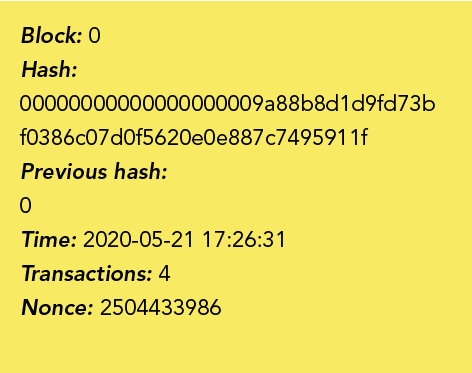
Example of a block (©2023 Let’s Talk Science).
Image - Text Version
Shown is black text on a yellow background.
It reads:
Block: 0
Hash:
0000000000000000000009a88b8d1d9fd73bf0386c07d0f5620e0e887c7495911f
Previous hash:
0
Time: 2020-05-21 17:26:31
Transactions: 4
Nonce: 2504433986
Did you know?
The first block in a blockchain is numbered block 0. We call this the genesis block.
You may be wondering, what a “hash” is. A hash is a unique set of numbers and letters that represent the block. It’s like a digital signature for the information in the block.
The hash in the image above is a real hash. It was generated using the SHA-256 hash generator. This is the hash generator used to create hashes for Bitcoin.
A hash generator is an algorithm that converts a string of text into a string of characters. The string that the SHA-256 hash generator creates is always 64 characters long. This is equivalent to 256 bits, hence the name. The “SHA” stands for Secure Hashing Algorithm.
Try this!
You can put any string of text into the SHA-256 hash generator and generate a hash. Try it using your name and see what hash you get!
One of the cool things about the hashes created using SHA-256 is that so far, there is no way to decode. This is because there are 2 256 possible numbers (1.5 x 1077) if you want to guess that right number. In other words, no one can put the 64 characters through an algorithm and get back the original string of text. For this reason, places other than Bitcoin use SHA-256 to verify identities. In other words, to make sure people are who they say they are online.
Another cool thing is that it is pretty much impossible for someone to go in and change the data in a block. If even the smallest bit of data changes in a block, a different hash is automatically generated.
For example, let’s say that a hacker wanted to change the data in Block 1.

Example of three blocks (©2022 Let’s Talk Science).
Image - Text Version
Shown is an illustration of three coloured squares with black text, two connected by chain links.
The first block, on the left, is yellow. It reads:
Block: 0
Hash: 00000000000000000009a88b8d1d9fd73bf0386c07d0f5620e0e887c7495911f
Previous hash:
0
Time: 2020-05-21 17:26:31
Transactions: 4
Nonce: 2504433986
A long black arrow points from the hash to the time in the next block. This block is connected by a black chain link to the next block.
This second block is teal. It reads:
Block: 1
Hash: 000000000000000000026ae784d194a5760464348329af4eb9fca2b27bbf8237
Previous hash:
00000000000000000009a88b8d1d9fd73bf0386c07d0f5620e0e887c7495911f
Time: 2020-06-21 15:26:31
Transactions: 3
Nonce: 52444663986
A long black arrow points to the time line in this block, and the hash number is in red. A red arrow points from the hash to the time in the third block. A large red X is above this arrow, in the space between the two blocks. This block is connected by a black chain link to the next one.
The third block is green. It reads:
Block: 2
Hash: 65013dbf913a36cdabc6ac44df0fdbb0bb1197dd2deb4023f2767d778f2f1ad7
Previous hash:
000000000000000000065013dbf913a36cdabc6ac44df0fdbb0bb1197dd2deb0
Time: 2020-06-22 08:05:15
Transactions: 2
Nonce: 58024648
Perhaps they want Person A to give Person C $100 instead of $10. Because the information in the block changed, so does its hash. But Block 2 still contains the old hash of Block 1. This makes Block 2, and all the blocks that come after it invalid as they do not have the correct hash of the previous block.
Bitcoin Mining
The nodes and miners have very important roles to play. Nodes keep a copy of the entire blockchain and relay transactions. Miners verify or check the data in the blocks by solving complex math problems - they help keep the system honest. Otherwise, anyone can walk away with your money. To check a block, a “miner” combines the list of transactions with a magic number called the nonce. This random number helps to make sure that the same transaction data is only submitted once to prevent double spending. More miners means faster transaction verifications and less fraud.
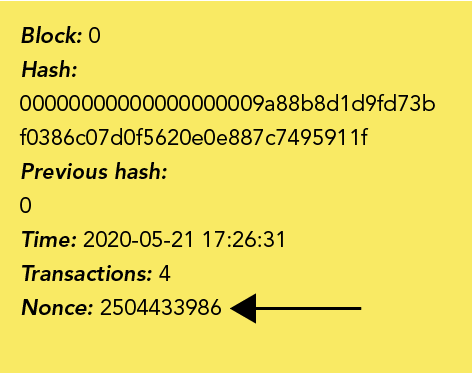
Example of a block with an arrow pointing to the nonce number (©2023 Let’s Talk Science).
Image - Text Version
Shown is black text on a yellow background.
It reads:
Block: 0
Hash:
0000000000000000000009a88b8d1d9fd73bf0386c07d0f5620e0e887c7495911f
Previous hash:
0
Time: 2020-05-21 17:26:31
Transactions: 4
Nonce: 2504433986
A large black arrow points from the right to the sequence of numbers on the last line.
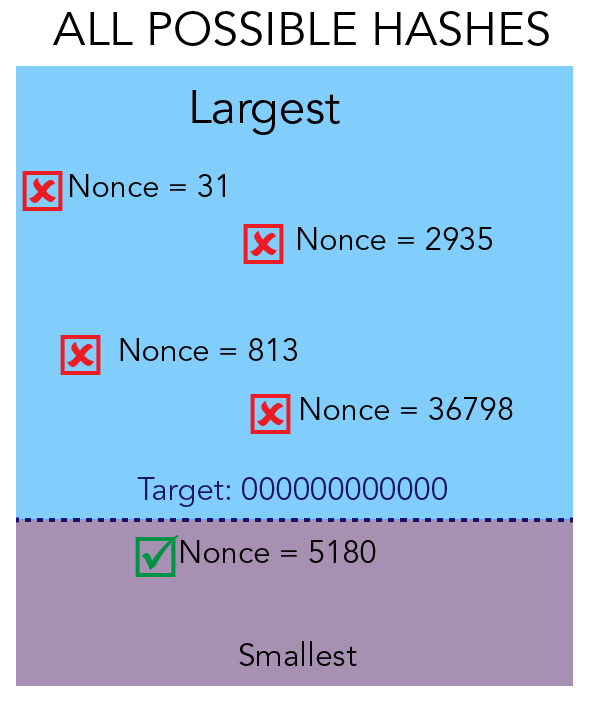
Hashes for various nonces relative to the target (©2023 Let’s Talk Science).
Image - Text Version
Shown is black text on blue and purple blocks.
The title "All Possible Hashes" is in capital letters across the top. Below, the image is divided into a pale blue square with a purple rectangle below. The two blocks are divided by a black dotted line.
In the blue square, the title "Largest" is in bold letters in the top centre. Below, on the top left, is a square with a red X, next to text that reads, "Nonce = 31." Below and to the right is another red X next to text reading, "Nonce = 2935." Below and to the left a third red X is next to the words, "Nonce = 813." Below and to the right, a fourth X is next to the words, "Nonce = 36798." Across the bottom edge of the blue area are the words, "Target = 000000000000."
In the purple rectangular section, at the top centre, is a box with a green checkmark. Next to the this are the words, "Nonce = 5180." Along the bottom edge of the purple area is the word "Smallest."
All this guessing takes a lot of computing power (and energy).
Did you know?
The difficulty is adjusted every 2016 blocks (every 2 weeks approximately) so that the average time for adding blocks is around 10 minutes.

Bitcoin mining hardware (Source: eclipse_images via iStockphoto).
Image - Text Version
Shown is a colour photograph of a person using a smartphone and laptop, next to a series of silver boxes connected by red and black wires.
The six boxes are mounted on a rack above a wooden desk. Each one is connected by red and black cables to another box on the desk below. To the right, a person is seen from the back, sitting at the desk. They are holding a phone with one hand, and using the trackpad on a silver laptop with the other. Both screens are filled with lines of text on a black background.
How long does it take to mine a Bitcoin?
Although technically it takes around 10 minutes to mine just one Bitcoin, this is only with really powerful computers. Forr most people, it takes around 30 days to mine one Bitcoin. So, depending on where you live, that can be quite an electricity bill!
In conclusion
Blockchain technology is likely to be used even more in the future for situations in which keeping correct records is important. This includes things like storing medical and property records, tracing supply chains and even voting. Blockchain is not without its downsides. Computers that mine data use a lot of electricity! Depending on how the electricity is generated, there can be significant environmental impacts.
Learn More
What is the Blockchain? (2018)
This video (3:51 min.) by a kid for kids, has a simple and visual explanation of blockchain.
Still Confused About Blockchain? Use This Explanation Even a 6-Year-Old Can Understand
This article compares blockchain to magical kingdoms and swords. It is a great analogy for children and adults alike.
Blockchain Tutorial: Learn Blockchain Technology with Examples (2022)
This page has straightforward information including lots of images and examples.
But how does bitcoin actually work?
This video (25:15 min.) from 3Blue1Brown explains in detail how Bitcoin works. The video covers topics such as decentralization, double spending, ledgers and the blockchain.
References
3Blue1Brown (2018). But how does bitcoin actually work? [Video]. YouTube.
Corporate Finance Institute (n.d.). Introduction to Cryptocurrency.
Darlington, N. (Oct 18, 2022). Blockchain for Beginners: What Is Blockchain Technology? A Step-By-Step Guide. BlockGeeks.
Frankenfield, J. (Jan 9, 2022). What is a Block in the Crypto Blockchain, and How Does it Work? Investopedia.
Geeks For Geeks (Jan 3, 2023). Introduction to Blockchain Technology.
Hayes, A. (Sep 27, 2022). Blockchain Facts: What Is It, How It Works, and How It Can Be Used. Investopedia.
Kiddle (n.d.). Blockchain facts for kids.
Liao, N. (n.d.). A Brief Introduction to Blockchain. Yale Law School Center for the Study of Corporate Law.
Raj, R. (Dec 29, 2022). How Does Blockchain Work? Intellipaat.
TechiSource (2022). How Mining Works: The Cryptographic Puzzle [Video]. YouTube.
Thakkar, M. (Apr 22, 2022). SHA 256 Algorithm Explained by a Cyber Security Consultant. SectiGoStore.
Thompson, B. (Jan 18, 2023). Blockchain Tutorial: Learn Blockchain Technology. Guru99.
Wetson, G. (Jul 15, 2022). Explain Blockchain To A Child. 101 Blockchains.
Wikipedia (n.d.). Blockchain.